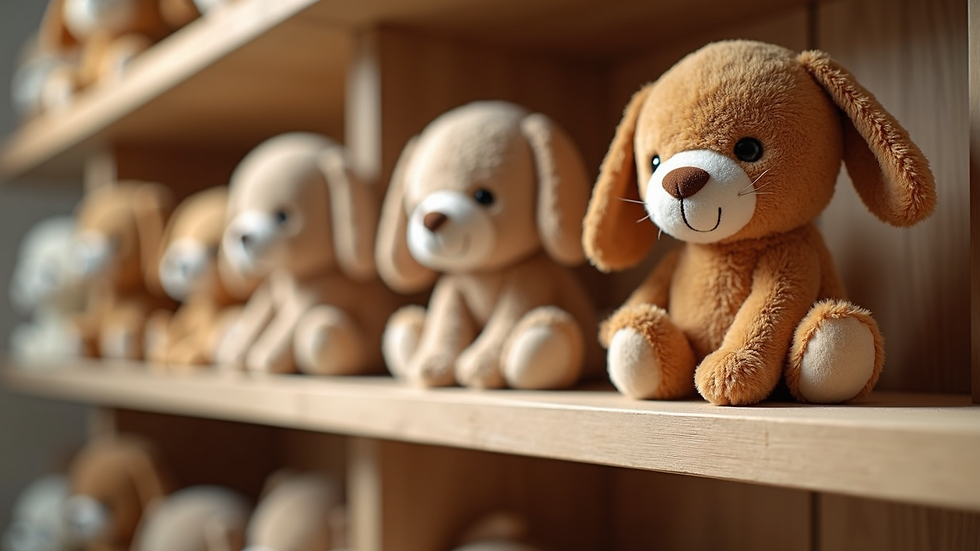Why Choose Sustainable Stuffed Animals for Your Family
- Baby Doll
- Aug 21
- 3 min read
Choosing toys for children is an important decision for many families. Beyond fun and play, toys can influence values and habits. Eco-friendly plush toys are becoming a popular choice for parents who want to combine safety, sustainability, and joy. These toys offer a gentle way to introduce children to caring for the planet while providing comfort and companionship.
Benefits of Eco-Friendly Plush Toys
Eco-friendly plush toys are made with materials and processes that reduce harm to the environment. They often use organic cotton, recycled fabrics, or natural dyes. This means fewer chemicals and less pollution during production. For families, this translates to safer toys that are less likely to cause allergies or skin irritation.
Some key benefits include:
Reduced environmental impact: Using renewable or recycled materials helps conserve resources.
Non-toxic materials: Safer for children’s sensitive skin and overall health.
Durability: High-quality eco-friendly toys often last longer, reducing waste.
Ethical production: Many brands ensure fair wages and safe working conditions.
Choosing eco-friendly plush toys also supports companies committed to sustainability. This encourages more businesses to adopt green practices, creating a positive ripple effect.

How Eco-Friendly Plush Toys Support a Greener Future
Eco-friendly plush toys contribute to a greener future in several practical ways. First, they reduce landfill waste. Traditional stuffed animals often contain synthetic fibers that do not biodegrade. In contrast, eco-friendly options use biodegradable or recyclable materials.
Second, these toys often come with minimal or recyclable packaging. This reduces plastic waste and excess materials. Families can also reuse or recycle packaging easily.
Third, many eco-friendly plush toys are produced locally or with reduced transportation emissions. This lowers the carbon footprint associated with shipping.
To make the most of these benefits, consider:
Choosing toys made from certified organic or recycled materials.
Supporting brands with transparent sustainability policies.
Recycling or donating old toys instead of discarding them.
By making informed choices, families can enjoy toys that are both fun and environmentally responsible.

Do stuffed animals shed microplastics?
Microplastics are tiny plastic particles that pollute oceans and harm wildlife. Many conventional stuffed animals contain synthetic fibers like polyester, which can shed microplastics during washing or wear. These microplastics enter waterways and contribute to environmental damage.
Eco-friendly plush toys made from natural fibers such as organic cotton or wool do not shed microplastics. This makes them a safer choice for the environment. Additionally, washing these toys gently and less frequently can reduce fiber loss.
Parents can take these steps to minimize microplastic pollution:
Choose stuffed animals made from natural or recycled fibers.
Use gentle washing methods and avoid harsh detergents.
Air dry toys instead of using dryers to reduce fiber shedding.
By selecting eco-friendly plush toys, families help reduce microplastic pollution and protect ecosystems.

Practical Tips for Choosing Sustainable Stuffed Animals
When shopping for stuffed animals, it’s important to look beyond appearance. Here are some practical tips to find the best sustainable options:
Check the materials: Look for organic cotton, bamboo, hemp, or recycled polyester.
Look for certifications: GOTS (Global Organic Textile Standard), OEKO-TEX, or Fair Trade labels indicate safer and ethical production.
Consider the stuffing: Natural fillings like wool or kapok are eco-friendly alternatives to synthetic polyester.
Evaluate durability: Well-made toys last longer and reduce the need for replacements.
Research the brand: Choose companies committed to sustainability and transparency.
For example, sustainable stuffed animals often meet these criteria and provide a wide range of adorable, eco-conscious options.
Encouraging Eco-Friendly Habits Through Play
Toys are more than just objects - they are tools for learning and growth. Eco-friendly plush toys can help children develop a sense of responsibility toward the environment. Parents can use these toys to:
Teach about recycling and resource conservation.
Encourage gentle care and repair of toys instead of discarding.
Discuss the importance of choosing products that protect the planet.
Involving children in selecting and caring for their toys fosters mindfulness and respect for nature. This early education can inspire lifelong eco-friendly habits.
Choosing eco-friendly plush toys is a meaningful step toward a healthier planet and a happier family. By prioritizing sustainability, safety, and quality, families can enjoy toys that bring joy and make a positive impact.



Comments